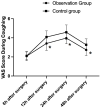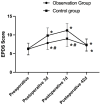The effect of an intravenous analgesic pump with esketamine on postoperative pain and postpartum depression in women with cesarean section
- PMID: 40384998
- PMCID: PMC12082501
- DOI: 10.62347/UNDQ7425
The effect of an intravenous analgesic pump with esketamine on postoperative pain and postpartum depression in women with cesarean section
Abstract
Objective: This study aims to investigate the efficacy of an intravenous analgesic pump containing esketamine for postoperative pain relief and its impact on postpartum depression in women undergoing cesarean sections.
Methods: A retrospective analysis was conducted on 147 women who underwent cesarean deliveries at Xiamen Hospital of Traditional Chinese Medicine from April 2022 to May 2024. Based on different pain management protocols, the participants were divided into two groups: the observation group (n=81) and the control group (n=66). The observation group received intravenous esketamine post-delivery, followed by postoperative analgesia using a pain pump with esketamine and Sufentanil. Various outcomes were assessed, including Visual Analog Scale (VAS) pain scores, Edinburgh Postnatal Depression Scale (EPDS) scores, and serum levels of interleukin-6 (IL-6), tumor necrosis factor-alpha (TNF-α), cortisol (Cor), and brain-derived neurotrophic factor (BDNF).
Results: At 12, 24, and 48 hours post-surgery, VAS pain scores (both resting and coughing) were significantly lower in the observation group compared to the control group (P<0.05). EPDS scores were significantly higher at 3, 7, and 42 days post-surgery in both groups compared to pre-surgery levels (P<0.05), with the observation group exhibiting significantly lower EPDS scores at 3 and 7 days (P<0.05). Serum levels of IL-6, TNF-α, and Cor were significantly reduced at 24 and 48 hours post-surgery in both groups, while BDNF levels were significantly elevated (P<0.05). At 24 and 48 hours, the observation group had significantly lower levels of IL-6, TNF-α, and Cor, along with higher BDNF levels, compared to the control group (P<0.05). No significant differences in adverse reactions were observed between the two groups (P>0.05).
Conclusion: Esketamine-based postoperative analgesia for cesarean section effectively reduces perioperative pain, alleviates postpartum depression, mitigates inflammatory and stress responses, and has certain neuroprotective effects. Its safety profile supports its potential for broader clinical use.
Keywords: Esketamine; caesarean section; intravenous analgesia; postpartum depression; postpartum pain.
AJTR Copyright © 2025.
Conflict of interest statement
None.
Figures




Similar articles
-
Effect of intraoperative injection of esketamine on postoperative analgesia and postoperative rehabilitation after cesarean section.World J Clin Cases. 2024 Oct 6;12(28):6195-6203. doi: 10.12998/wjcc.v12.i28.6195. World J Clin Cases. 2024. PMID: 39371565 Free PMC article. Clinical Trial.
-
Impact of esketamine intravenous analgesic pump on pain and depression post-cesarean.BMC Surg. 2025 Apr 8;25(1):144. doi: 10.1186/s12893-025-02868-y. BMC Surg. 2025. PMID: 40200243 Free PMC article.
-
Efficacy of esketamine for the treatment of postpartum depression and pain control following cesarean section: a randomized, double-blind, controlled clinical trial.BMC Anesthesiol. 2024 Feb 6;24(1):52. doi: 10.1186/s12871-024-02436-6. BMC Anesthesiol. 2024. PMID: 38321436 Free PMC article. Clinical Trial.
-
Efficacy and safety of perioperative application of esketamine on postpartum depression: A meta-analysis of randomized controlled studies.Psychiatry Res. 2024 Mar;333:115765. doi: 10.1016/j.psychres.2024.115765. Epub 2024 Feb 2. Psychiatry Res. 2024. PMID: 38330640 Review.
-
Esketamine combined with sufentanil versus sufentanil in patient-controlled intravenous analgesia: a meta-analysis.Front Pharmacol. 2024 Feb 7;15:1247646. doi: 10.3389/fphar.2024.1247646. eCollection 2024. Front Pharmacol. 2024. PMID: 38384296 Free PMC article. Review.
References
-
- Wen Y, Mao M, Wang X, Xu C, Shi X, Li P, Tian Z, Jiang M, Yuan H, Feng S. Efficacy and safety of perioperative application of esketamine on postpartum depression: a meta-analysis of randomized controlled studies. Psychiatry Res. 2024;333:115765. - PubMed
-
- Sarı E, Güngör Satılmış İ. The effect of acupressure on lactation in non-breastfeeding mothers after preterm cesarean delivery. Health Care Women Int. 2023;44:361–373. - PubMed
-
- Corbaz F, Boussac E, Lepigeon K, Gomes Dias D, Marcadent S, Desseauve D, Horsch A. ‘connEcted caesarean section’: creating a virtual link between MOthers and their infanTs to ImprOve maternal childbirth experieNce - study protocol for a PILOT trial (e-motion-pilot) BMJ Open. 2023;13:e065830. - PMC - PubMed
-
- Arroyo-Fernández FJ, Calderón Seoane JE, Torres Morera LM. Strategies of analgesic treatment after cesarean delivery. Current state and new alternatives. Rev Esp Anestesiol Reanim (Engl Ed) 2020;67:167–175. - PubMed
LinkOut - more resources
Full Text Sources
Miscellaneous
